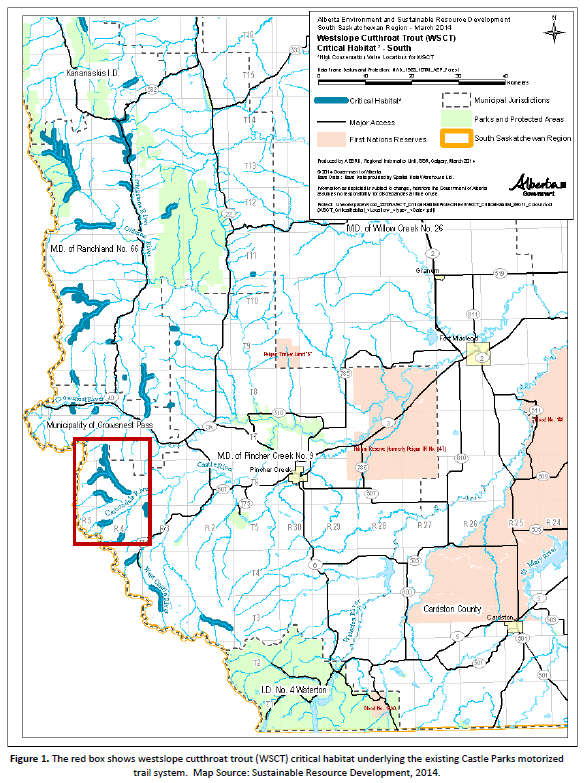

AWA Letter on Motorized Trails in the Castle Parks
August 1, 2019
- •
- •
- •
PDF copy of AWA Letter on Motorized Trails in the Castle Parks
August 1, 2019
The Honourable Jason Nixon
Minister of Environment and Parks
By email: aep.minister@gov.ab.ca
RE: Update Report – Castle Parks and Adjacent Public Lands
Dear Minister Nixon,
Further to the Government of Alberta’s July 11, 2019 newsletter – Update on the Castle parks and adjacent public land, Alberta Wilderness Association (AWA) is writing to lend our support for the implementation of the final Castle Management Plan, in particular the completion of restoration plans and protective measures for threatened westslope cutthroat trout in critical habitat within the Castle Parks.
As one of many stakeholders representing a diverse group of interests and users, AWA participated in extensive consultation opportunities that led to the development of the Castle Parks Management Plan. The plan recognizes the Castle’s wilderness values, and its importance to Indigenous communities and recreationists. The consultation process facilitated productive discussions about the ecological and recreational values of the Castle and which activities were compatible with its protection and restoration.
The Castle Wilderness contains critical habitat for threatened westslope cutthroat trout and is recognized as core grizzly bear habitat. With numerous overlapping ecosystems in one relatively small area, the Castle Wilderness contains significant animal and plant species diversity and provides essential headwaters for the Oldman River basin. Throughout the past several decades, activities including oil and gas exploration and development, livestock grazing, clear-cut logging and high-impact recreation have caused substantial disturbance to the Castle[1].
Critical habitat for westslope cutthroat trout
- An important issue that emerged during the consultation process is that the Castle contains populations of threatened westslope cutthroat trout, whose habitat is protected under the Species at Risk Act. Penalties for each count of destroying any part of critical habitat include fines of up to $1,000,000 or imprisonment for up to 5 years.
- The planning process recognized that any activities with the potential to destroy westslope cutthroat trout critical habitat were inappropriate, especially within a protected area. An addendum for the Castle Parks Management Plan released in March 2017[2] states that in an “analysis of environmental data, reports and published science (including research related to biodiversity, critical habitats, linear thresholds, species at risk, riparian areas, erodibility and noise disturbance potential) confirms that summer recreational off-highway vehicle use at current or substantially reduced levels is incompatible with conservation goals of the parks.” (Emphasis added)
- A 2017 report by Alberta’s Environmental Monitoring and Science Division, Ecological Response to Human Activities in Southwestern Alberta: Scientific Assessment and Synthesis[3], re-emphasized that the Castle contains threatened populations of westslope cutthroat trout that require “clean, cool, complex and connected watercourses.”
The report states, “roads and trails in the region cross watercourses thousands of times, with each crossing providing a potential pathway for increased sediment inputs, increased runoff rates, and altered magnitude of flow and water quality in headwater streams.” (p. 6). In addition, “Studies throughout the range of [westslope cutthroat trout and bull trout] in western North America suggest that their populations in the Castle region are negatively affected by roads and other linear footprints.” (p. 7) - 132 km of motorized trails currently remain within the Castle Parks. These directly overlap critical habitat for westslope cutthroat trout (Figure 1).
- Provisions exist in the Castle Parks Management Plan to accommodate the removal of motorized recreation within the sensitive landscapes of the Castle Parks. These include working with a variety of land-use and recreational stakeholders to create a sustainable network of motorized trails on adjacent public lands (Livingstone and Porcupine Hills Public Land Use Zones).
It has been well-established in both scientific literature and reports produced by the Government of Alberta that motorized trails are incompatible with the Castle Parks, largely due to legal obligations to protect and restore westslope cutthroat trout critical habitat.
AWA supports motorized trails in appropriate places on designated and well built trails; we are supportive of science-based processes to “develop sustainable trails and more effectively manage outdoor recreation activities” on public lands. However, we emphasize that motorized recreation is not sustainable in protected areas, particularly in areas containing westslope cutthroat trout critical habitat.
We look forward to your response and invite any opportunity for further discussion.
With regards,
ALBERTA WILDERNESS ASSOCIATION
Grace Wark, Conservation Specialist
cc:
Bev Yee, Deputy Minister, Alberta Environment and Parks, bev.yee@gov.ab.ca
Peter Swain, Regional Director, Parks South Region, peter.swain@gov.ab.ca

References:
[1] Lee and Hanneman, 2010; Mayhood, Sawyer and Haskins, 2004
[2] https://open.alberta.ca/dataset/1472514b-63ea-491d-ba3c-d0bf19e61867/resource/3d5fb105-ef7c-4534-97ca-ca834b5da95a/download/castlemgmtplanaddendum-mar2017-a.pdf
[3] https://open.alberta.ca/dataset/e77ce35a-230d-4aff-9df9-e15ccb4ddf04/resource/8a3af9fe-e4ec-4914-92ae-b25774866421/download/emsdcastlesciencereviewv58final.pdf
